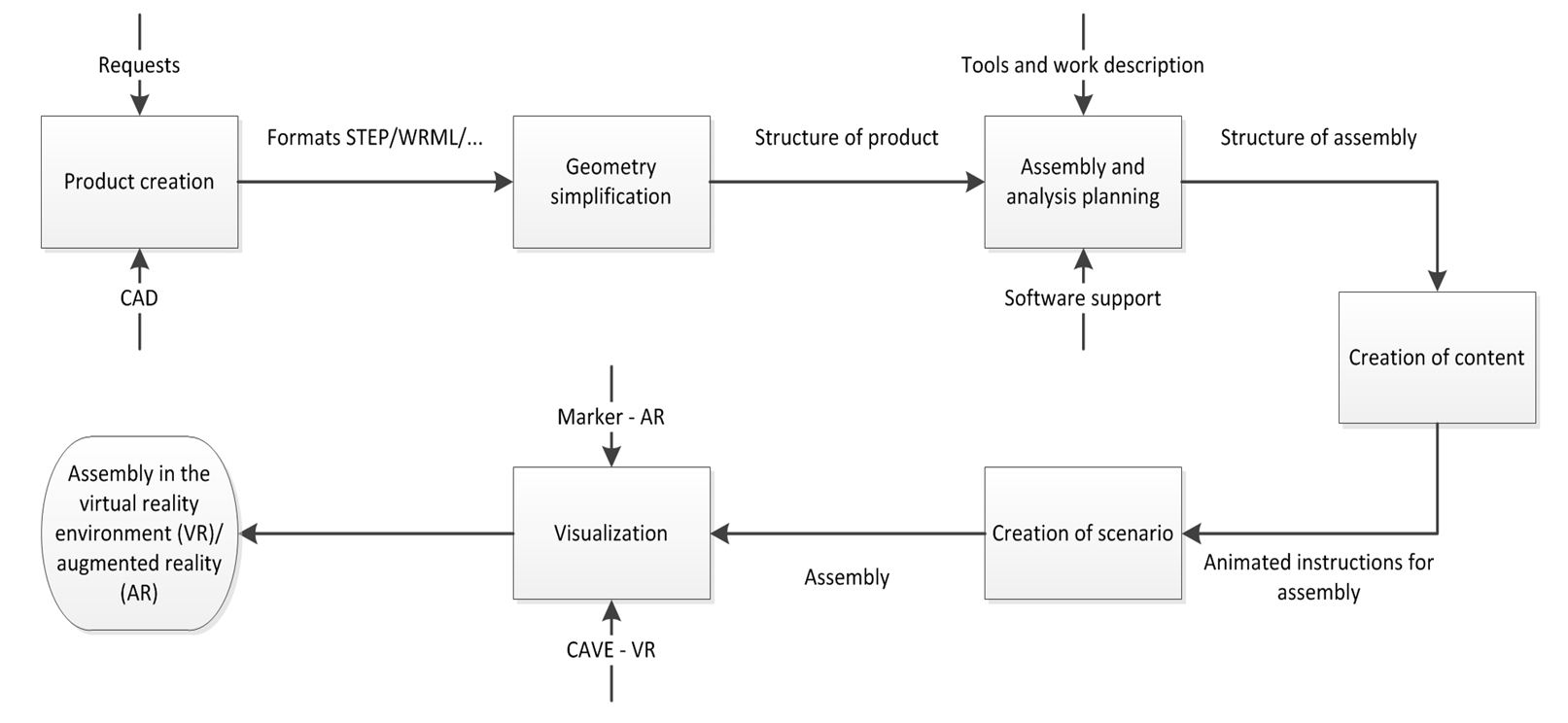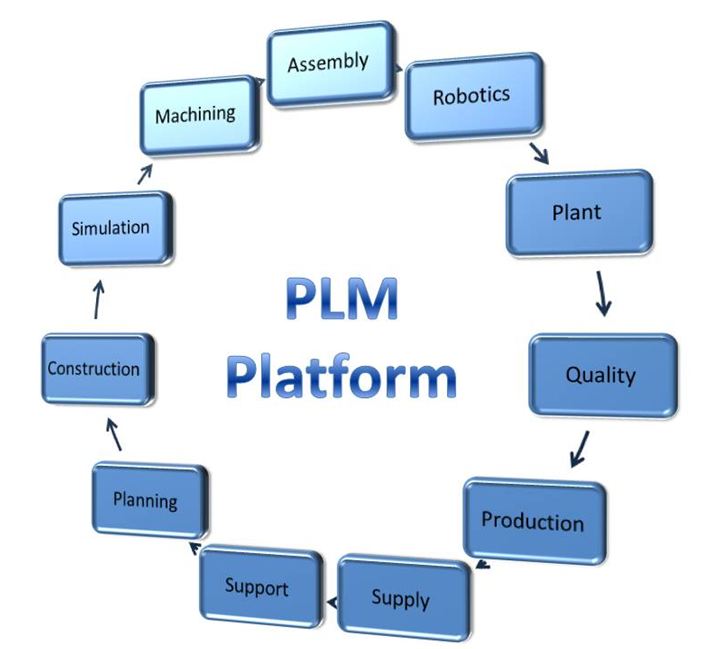VIRTUAL REALITY TOOLS AS A PART OF PLM CONCEPT
Jozef HNÁT, Patrik GRZNÁR
Abstract This article highlights the importance of using visualization tools in the life cycle management (PLM). Main idea and platform of PLM is mentioned in the article, but the main part of the article is focused on virtual reality tools and its usage in the process of assembly design.
1. INTRODUCTION
In the past we used to search for weaknesses in organization and management of work, later in the creation of giant corporations, using mainly reduction of costs on supply inputs. Then computer technology came and the first real results have been done by ERP systems, which made the order in stock inventories and could reduce overall operating costs. It was followed by CRM and SCM systems, which helped to shorten delivery times and reduce costs.
2. PLM STRATÉGIA
The ability to effectively manage product life cycle from initial concept to disposal and recycling represents next level of company development, giving a presumption of success in the market. This requires a huge amount of correct information, correctly evaluated and properly used. It is necessary that this information must be available at the actual time for those workers who need them, so they can use them and exchange them, wherever they are located in the world. It is necessary to work with this information during development of strategic business plans, development plans, definition of conceptual properties of product and its development, manufacture, marketing, sales or service at any time in the life cycle of the product, and very often much sooner or even long after its life. Every manufacturer has a different nature of their products, operates in different markets, in different environment. Product Lifecycle Management (PLM) is a business strategy that provides space for innovation, development, production, promotion and retirement products in its life cycle in large corporations as well as small businesses. It captures best Product creationpractices, knowledge, processes and intellectual property for re-use.
PLM solution is not software and it is not an application. PLM solution is set of rules, tools, software, standards and actions within which the software is an important tool to meet this corporate strategy. PLM consists of many elements including:
- unified technologies and standards (e.g. data exchange formats, visualization, collaboration and integration with other enterprise subsystems),
- data core functions - PDM (such as data bank, documentation, data management, workflow and process management),
- graphic and text editors and engineering systems (e.g. CAD / CAM systems),
- functional applications (specialized for the needs of the user).
Product Lifecycle Management simplifies business processes and integrates them with ERP, SCM and CRM systems. This leads to the introduction of permanent, repeated functions, processes and information throughout the product life cycle - from idea to retirement. Producers who implemented PLM achieve benefits by reducing costs, faster innovation and increasing the share of their products in the market. The main part of the PLM strategy is the concept of Digital Factory [2]. In addition to common data management (PDM), the use of CAx systems and other support tools for managing product life cycle, it is important the ability to visualize and present the designed solutions. Tools of augmented reality (AR) represent a powerful tool in this process. Thanks to their interactivity they help to reduce the time needed for choosing appropriate solutions and decisions.
3. USAGE OF VIRTUAL REALITY TOOLS DURING DESIGN OF ASSEMBLY IN THE PLMAssembly represents a significant and potential area for innovation activities in manufacturing. Assembly represents high proportion of total production time in many companies. It is important to avoid any possible errors before the start of production. This can be done by testing of assembly in a virtual environment. The actions proposed in the virtual assembly are essential because they provide higher productivity, help to increase competitiveness of production, its quality, etc. System of virtual assembly is realized on the bases of the real assembly exercises. Application achieves high speed on a standard personal computer. An important outcome for the user is the natural linkage with a virtual reality environment. There are no special knowledge or computer skills required while working in the environment of virtual reality. Assembly with using gloves and tracking sensors provides an easy and uninterrupted way of work. [1] Importance of virtual reality is that the virtual environment can be shared by many users simultaneously, while they can interact. In this way, more people can work together to solve problems.
Way of virtual reality applications in industry:
- visualization - simulation is represented in 3D,
- interactivity - user interaction (twitching hands, movement, press one button, click the item) affects the simulation,
- simulation - 3D models of real or imaginary environment are simulated by using a computer.
Following figure shows the schematic representation of the assembly system design with virtual reality tools. [4]

Product creation - in the first step CAD model is created. This model is exported into a standard format STEP (Standard of the Exchange of Product Data Model) (ISO103031994), containing the product structure and 3D model of the product. This format allows you to record and thus transmit information that occur during the development-design as well as technologic-implementation cycle. It allows transfer of a wide range of geometrical and non-geometrical information relating to various areas of processing.
Geometry simplification - models simplification is achieved by removing the details (small holes, etc.). The final model is build from triangles.
Assembly and analysis planning - apart from the parts of assembly you need to enter additional information, such as the assembly procedure, work descriptions, time required to perform each operation, as well as information about the tools. Each product is defined by:
- individual parts,
- assembly operations,
- needed tools.
Creation of content and scenario - the individual work instructions are assigned to parts or sub-assemblies. Each component has defined position, rotation angle, type of animation and duration (seconds). After defining the entire assembly it is possible to simulate process.
Visualization - as imaging devices are commonly used monitors with camera. Here it is possible to use conventional paper markers as identification marks. After identification of marker, computer assigns the correct 3D object. Worker can rotate the assembly as needed. Displayed objects are highlighted by colored border for better visualization.
Virtual reality tools in addition to providing support for workers in their work, allows to shorten assembly time and time for "learning".
4. CONCLUSIONNew unique technologies, we can currently use, offer miracles. You just have to reach for them. The current time of digitizing represents a significant movement towards achieving more and more realistic representation of modeled and digitized world. Development of the automotive, electronics and aerospace industry brings new approaches. These approaches use rapid prototyping technologies, digitization, virtual reality and simulation. This paper was made about research work support: KEGA 065ŽU-4-2014. References [1] GÖRNER, T., HOŘEJŠÍ, P.: Virtuální realita, SmartMotion, Plzeň 2011, ISBN 978-80-87539-02-6. [2] GREGOR, M. 2015. Digitalizácia a aizácia v priemysle – východiská. In ProIN. ISSN 1339 – 2271, 2015, roč. 16, č. 4, s. 15-20. [3] MIRANDOVÁ, G. – KRAJČOVIČ, M. 2011. Rozšírená realita v montáži. In: MOPP 2011 Modelování a optimalizace podnikových procesů [elektronický zdroj] : 13. ročník mezinárodního semináře : 24.-25.11.2011. Plzeň: Západočeská univerzita, 2011. - ISBN 978-80-261-0060-7. [4] MIRANDOVÁ, G. – KRAJČOVIČ, M. 2011. Use of augmented reality in industrial engineering. In TRANSCOM 2011 : 9-th European conference of young research and scientific workers. Žilina : University of Žilina, 2011. ISBN 978-80-554-0370-0. s. 193-196. [5] http://www.plm.aion.siemens.com/cz_cz/
Authors:
* Ing. Jozef Hnát, PhD., Department of Industrial Engineering, Faculty of Mechanical Engineering, University of Žilina, Univerzitná 1, 010 26 Žilina, Slovak Republic, tel. 00421-0415132733, e-mail: jozef.hnat@fstroj.uniza.sk,
* Ing. Patrik Grznár, PhD., Department of Industrial Engineering, Faculty of Mechanical Engineering, University of Žilina, Univerzitná 1, 010 26 Žilina, Slovak Republic, tel. 00421-0415132733, e-mail: patrik.grznar@fstroj.uniza.sk,

